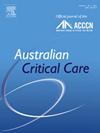Respiratory physiotherapy in intensive care: A survey investigating respiratory physiotherapy interventions for mechanically ventilated patients in the intensive care unit
IF 2.7
3区 医学
Q2 CRITICAL CARE MEDICINE
引用次数: 0
Abstract
Background
Physiotherapists play a key role in respiratory care for mechanically ventilated (MV) patients. Despite this, there is limited understanding of which interventions are commonly utilised to treat respiratory compromise in this cohort or what key barriers exist to their implementation.
Aims
The aim of this study was to identify preferred respiratory physiotherapy treatments for MV patients across Australian intensive care units (ICUs) and comprehend key barriers to their application.
Methods
A survey was sent to 145 of the 183 identified Australian ICUs listed in the Australian and New Zealand Intensive Care Society’s Centre for Outcome and Resource Evaluation report. The survey encompassed demographic details, queried the frequency of use for six interventions (using a Likert scale from “often” to “never”), and explored treatment indications, methods, and barriers through multiple-choice responses. Results were presented as proportions (counts and percentages) and relative frequencies (RFs). Group differences were assessed using chi-squared tests, with a p value <0.05 indicating significance.
Results
Of the 69 responses (48% response rate), most were from level 3 (67%, n = 46/69) public (83%, n = 57/69) ICUs, with <2.0 full-time equivalent physiotherapy staffing (49%, n = 34/69) for 5–15 beds (44%, n = 30/69). Manual techniques (e.g., percussions and vibrations) were the most common respiratory physiotherapy treatments, with 54% of respondents using them “often”, while intrapulmonary percussive ventilation was the least common, used “never” by 83%. Variation was noted in the application of hyperinflation. Calculation of maximal inspiratory pressure before completing inspiratory muscle training was common (74%). Overall, clinician competence (RF = 28%), confidence (RF = 21%), and access to clinical guidelines (RF = 20%) were the main barriers to implementing techniques, with barriers generally more prevalent among respondents from smaller, private, level 1 and 2 ICUs.
Discussion
While physiotherapists prioritise respiratory treatments for MV patients, significant variability exists in practice. This survey highlights the need for standardised guidelines, enhanced educational resources, and the requirement to support colleagues in smaller and private ICUs to ensure consistent, effective management of MV patients throughout Australian ICUs.
呼吸物理治疗在重症监护:一项调查调查呼吸物理治疗干预在重症监护病房机械通气患者
物理治疗师在机械通气(MV)患者的呼吸护理中起着关键作用。尽管如此,对于该队列中通常使用哪些干预措施来治疗呼吸损害,以及实施这些干预措施存在哪些主要障碍,了解有限。本研究的目的是确定澳大利亚重症监护病房(icu)中MV患者的首选呼吸物理治疗方法,并了解其应用的主要障碍。方法对澳大利亚和新西兰重症监护协会结果和资源评估中心报告中列出的183个澳大利亚icu中的145个进行调查。调查包含了人口统计细节,询问了六种干预措施的使用频率(使用李克特量表从“经常”到“从不”),并通过多项选择回答探讨了治疗适应症、方法和障碍。结果以比例(计数和百分比)和相对频率(RFs)表示。采用卡方检验评估组间差异,p值<;0.05表示差异有显著性。结果69例应答者(应答率48%)中,大多数来自三级icu (67%, n = 46/69)公立icu (83%, n = 57/69),拥有5-15张床位(44%,n = 30/69)的2.0名全职等效物理治疗人员(49%,n = 34/69)。手动技术(例如,敲击和振动)是最常见的呼吸物理治疗,54%的答复者“经常”使用它们,而肺内敲击通气是最不常见的,83%的人“从不”使用。在应用恶性通货膨胀时注意到变化。在完成吸气肌训练前计算最大吸气压力是常见的(74%)。总体而言,临床医生的能力(RF = 28%)、信心(RF = 21%)和获得临床指南(RF = 20%)是实施技术的主要障碍,障碍通常在小型、私人、1级和2级icu的受访者中更为普遍。虽然物理治疗师优先考虑呼吸治疗的MV患者,显著差异存在于实践中。这项调查强调需要标准化的指导方针,加强教育资源,并要求支持小型和私人icu的同事,以确保整个澳大利亚icu中MV患者的一致,有效的管理。
本文章由计算机程序翻译,如有差异,请以英文原文为准。
求助全文
约1分钟内获得全文
求助全文
来源期刊

Australian Critical Care
NURSING-NURSING
CiteScore
4.90
自引率
9.10%
发文量
148
审稿时长
>12 weeks
期刊介绍:
Australian Critical Care is the official journal of the Australian College of Critical Care Nurses (ACCCN). It is a bi-monthly peer-reviewed journal, providing clinically relevant research, reviews and articles of interest to the critical care community. Australian Critical Care publishes peer-reviewed scholarly papers that report research findings, research-based reviews, discussion papers and commentaries which are of interest to an international readership of critical care practitioners, educators, administrators and researchers. Interprofessional articles are welcomed.
 求助内容:
求助内容: 应助结果提醒方式:
应助结果提醒方式:


